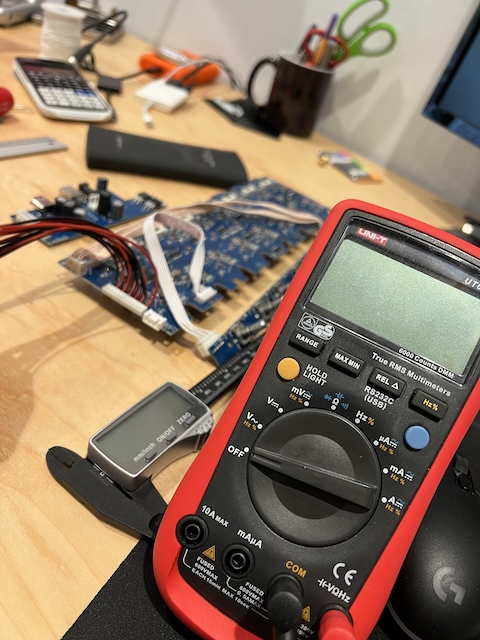When we set-up and maintained our console one thing we got rid of was the old Yellowtec System 4 fader-automation. Developed by our studio technician ACI in the late 1980ties for his employeer Thum+Mahr, the system was implemented in a lot of console back than but never been updated to modern computer technology. And as much as we love vintage gear we really didn’t wanted to maintain an old 386 PC in the studio just for fader automation…
Our Raindirk LN1 is equipped with 40 Penny+Giles PGF3220/D motor faders – back then the best fader money could buy – about 200 DM which is roughly 100 € per fader – in the 1980ies! Even nowaday you easily pay 80 – 200 € for a used one on Reverb or ebay.
The PGF3220/D has two seperate tracks: One for the audio signal and another digital one for the servo. Each fader has two connectors: One 5pin connector for the audio signal and another 6pin connector for the servo / fader automation.
When we stripped out the fader automation we also had to rewire all 40 faders and got rid of some additional wiring – the less wires the better!

Rewiring 40 faders…
The digital connector has a pretty common wiring – 3 wires for reading the fader, one for detecting the touch on the knob and two for controlling the servo:
| Pin 1 | Fader V+ |
| Pin 2 | Fader Wiper |
| Pin 3 | Fader Ground |
| Pin 4 | Touch |
| Pin 5 | Servo + |
| Pin 6 | Servo – |
The idea
.Having all the faders rewired we tought it might be cool to have a new fader automation – just in case 🙂
After some online research we figured out that the market for fader automation is pretty dense. Basically the main manufacturers like SSL or Neve have their own systems but it’s really hard to get a reasonable priced after market automation. Only thing which was quite interesting was Fadermate – a UK-based company who developed a retro fit fader automation. But even that systems starts at 1.745 € for just eight faders – and on the other hands the technology is heavily based on midi and a lot of additional hardware. But a no-go for us was that you have to use their faders which doesn’t make sense for us.
We discused with our stuido technician ACI and pretty fast the idea was born that we should try to connect one of the standard DAW controllers with motorized faders to our faders. So just get rid ot the internal faders of the controller and connect the wires to our faders. That simple.
After some research to find a reasonable priced, future proof and easy to use / integrate DAW controller we stumbled upon the Icon X+ – a pretty nice, very basic but well designed DAW controller with everything we were looking for:
- 8-channel DAW controller usable as a standalone unit without Platform M
- Expandable to 32-channels
- 8 touch-sensitive motorized faders with 10-bit resolution
- Mackie control build-in for Cubase, Nuendo, Logic Pro and Ableton Live.
- Mackie HUI protocol build-in for Pro Tools
And all that priced at 279 € incl. tax!
So we ordered one at Thomann and my son Glenn and our studio technician ACI opened the Icon for some research.
The Icon is equipped with some cheap motorized faders but the wiring is pretty much identical to the P+G faders: 3 for the fader, 2 for the motor and one for the touch.
The only difference is that the Icon faders operate on 5 Volt / 300 mA and the P+G on 12 Volt / 570 mA – but hey – other than that it looks quite good…

Glenn and ACI working on the Icon
After this first successful test Glenn and ACI made a plan how to built the k22 fader automation.
The Icon board would easily fit in the fader bay of the Raindirk console but you have to take care about interference and noise signals as the audio signal chain is really close by. So they decided to built their own board which houses the connections between the Icon and the P+G faders and also acts like a shielding.

The Icon faders
So we set-up a small test and just connected the P+G fader to the Icon and it worked surprisingly well! Even with the lower voltage the fader worked smoothly and was easily controllable through Logic X.
We also decided against using the additional DAW functionality of the Icon (Mute, record enable, dual function encoder knobs) as we do not want to built a DAW controller into our Raindirk but just a fader automation.
Another thing we have to try is to run the Icon at a higher voltage so the P+G faders get optimum voltage for the servo. As far we read the Icon design it shouldn’t be an issue to raise the voltage to 8 or 10 volt. Let’s see 🙂

The PCB for the project as designed by Glenn
So far – this is the actual status of the project and we’re waiting for the PCBs to move on!
Stay in tuned for the follow-up and the assembly of our k22 faderautomation.

